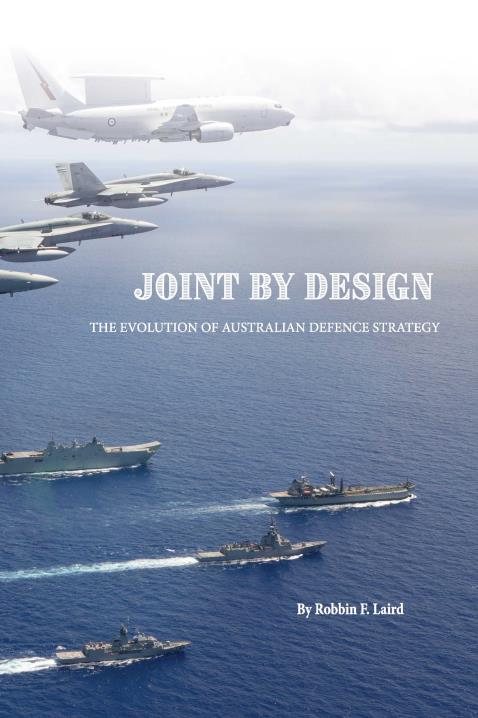Joint by Design: The Reshaping of Australian Defence Policy
Dr Robbin Laird brings a unique perspective to his analysis of the journey the Australian Defence Force (ADF) has been on over the last six years.
As an American, and also as a European based analyst, he understands the military and strategic realities of Europe and the United States and is therefore able to place Australia, as a modern middle-power, into the spectrum of Western Liberal Democracies.
And importantly, this book highlights the lessons that Europe and the United States could learn from Australia as the first quarter of the 21st century draws to a close.
This book is a modern history that begins in 2014.
The year 2014 might seem recent – however given the upheavals wrought upon the world by changing global power dynamics, national domestic political challenges, military transformations and finally, the pandemic – it could just as well be 60, not 6, years ago.
Chapter Two, The Return of Great Power Competition, specifically notes that 2014 ‘was also a key turning point, not quite as dramatic as the guns of August in 1914, but clearly significant, with its full significance to be determined by the history of our times. 2014 saw the clear and explosive return of Russia to European affairs; the Crimean take-over ended the dream of a global order of peace and prosperity dominated by a gentle globalization process…’
Dr. Laird explains why the behaviour of Russia was relevant in a discussion about an Australian Defence Force transformation in this way: ‘… what might not be more generally understood is that Russian actions in 2014 had a decisive impact on Australia.’
He expands this thesis as follows: ‘as Australia confronted Russian actions in 2014 [the commercial airliner shot down over the Russia-Ukraine border had 39 Australians on board; the deployment of a Russian naval task force off the coast of Northern Australia during the G20], the focus on the Australian Defence Force as a core capability to express and defend Australia’s sovereign interests was clearly demonstrated… In effect, the events of 2014 proved to be the launch point for the next phase of ADF development and highlighted its role in the defense of Australian sovereignty.’
The global strategic challenges of 2014 coincided with the decision by Australia to purchase the F-35 and to use that acquisition to drive a wider change in the combat force.
This was a significant turning point for the Royal Australian Air Force (RAAF), the ADF and the Australian government.
The section entitled Air Combat Operations: 2025 and Beyond, starts the transformation journey with a focus on 5th Generation airpower, but in essence, next generation warfighting triggered by the opportunities presented by the technological step-change of the F-35.
Importantly, there was an early acceptance that 5th Generation warfighting was something more than technological. The technology would only be effective when combined with modern, adaptable and adaptive, operational concepts, training, tactics, interoperability, workforce, and culture.
The title of this book actually provides the ‘clue’ to the success of a transformation – ‘by design’. ‘Top down design meets bottom up innovation’ was at the heart of the RAAF’s 5th Generation transformation and the core philosophy of the RAAF Plan Jericho, which is explored thoroughly in Chapter Three, and well worth reading.
Plan Jericho has become a template for modern militaries seeking to be fit-for-purpose in the 21st century.
The subsequent Chapters in the book explore and explain the integration of Sea and Land power into the 5th Generation Jericho framework. Indeed, the Royal Australian Navy took on board the Jericho principles and has forged ahead with a massive recapitalisation and renewal program.
But of course, none of these change / modernisation programs were taking place in a military-strategic vacuum.
Australia continued to play it’s part in contributing to global military operations, and the Australian government continued to evolve geostrategic and trade policies appropriate to the changing threat environments.
The chapters on Integrated Air and Missile Defence, Rethinking Conventional Deterrence and High-Intensity Operations and Sustaining Self-Reliance encapsulate this fusion, and sometimes friction, of military and national strategic priorities.
A unique feature of this book is the extensive program of interviews that underpin the narrative and analysis.
Dr. Laird has spoken to senior military personnel from the ADF, the United States, Europe and Asia, as well as strategic thinkers and commentators from reputable think-tanks, and Government officials and politicians.
It is worth noting that these interviews were undertaken at the time of the events they are discussing. They are conversations in a temporal context.
The passage of time has not refined or reframed the comments – they are not recollections.
And for anyone interested in history, these interviews are a goldmine.
As is the content of the entire book.
Anne Borzycki is the Director of the Institute of Integrated Economic Research – Australia
This book was released on Amazon, Barnes and Noble, and Kobo on December 22, 2020 in e book form with the paperback and hardback to be released in two months.
And in Australia on amazon Australia:
Or you can buy it directly through our website for 10% off if you use the code: Joint2020


